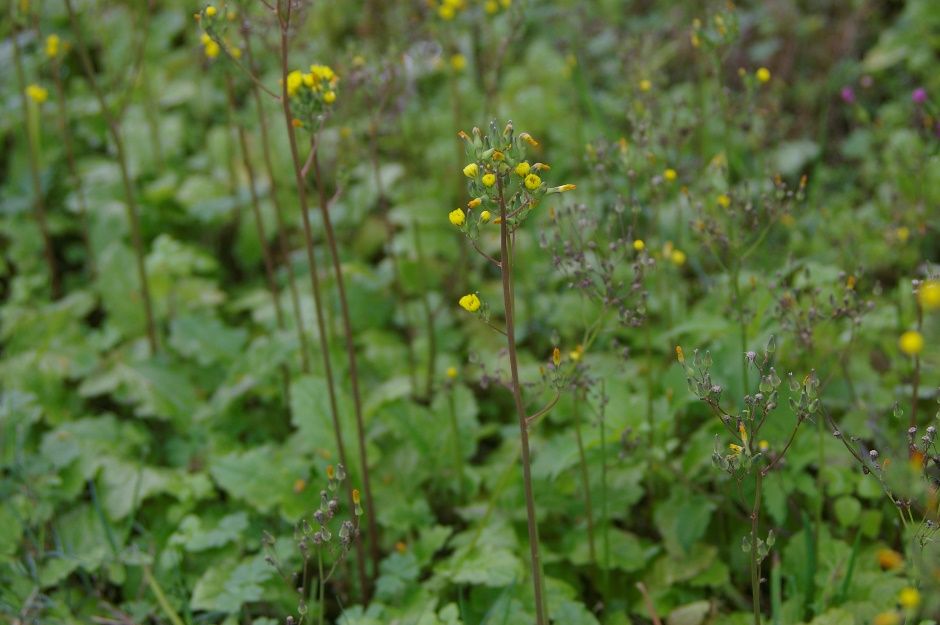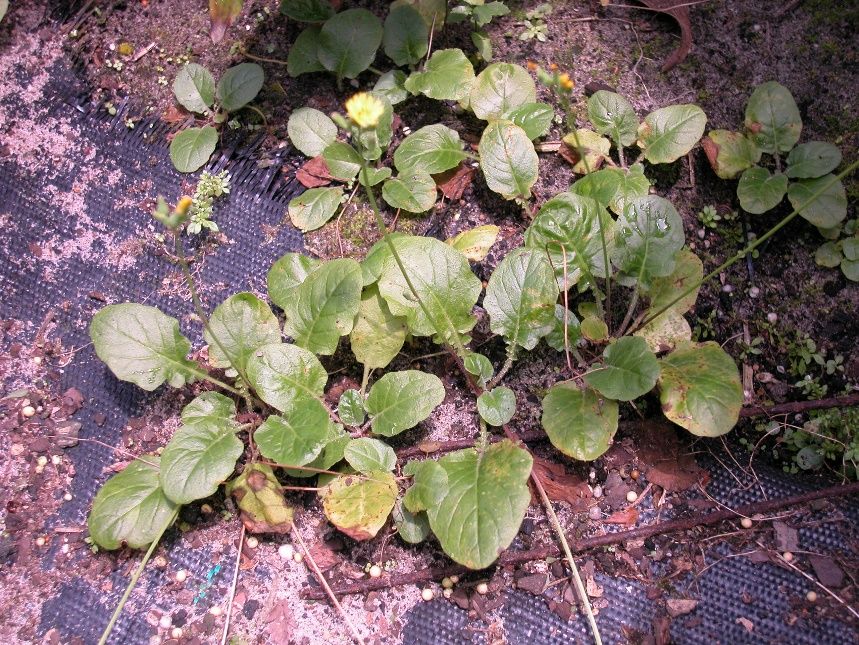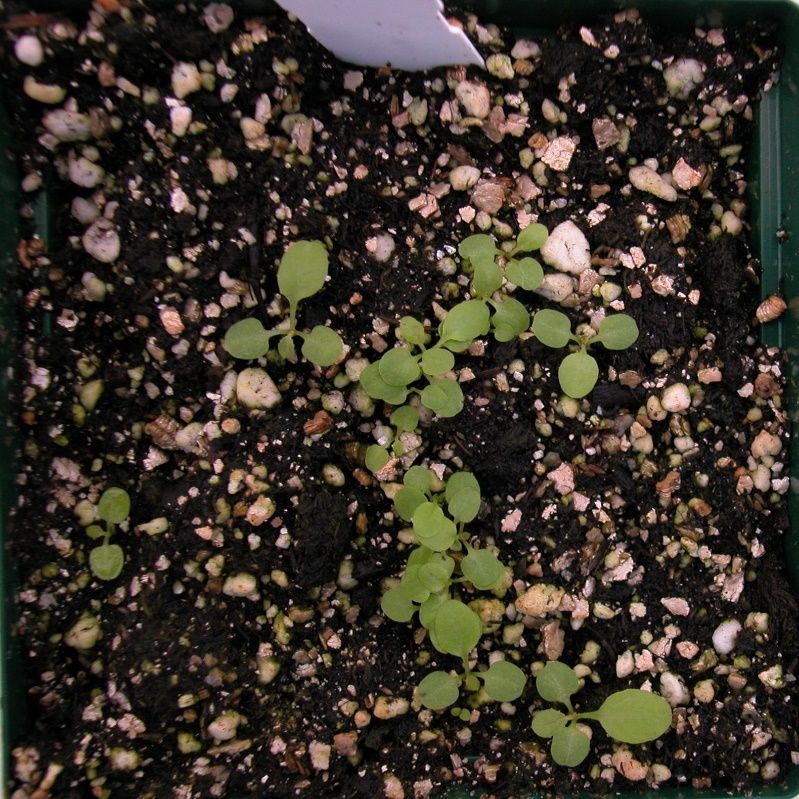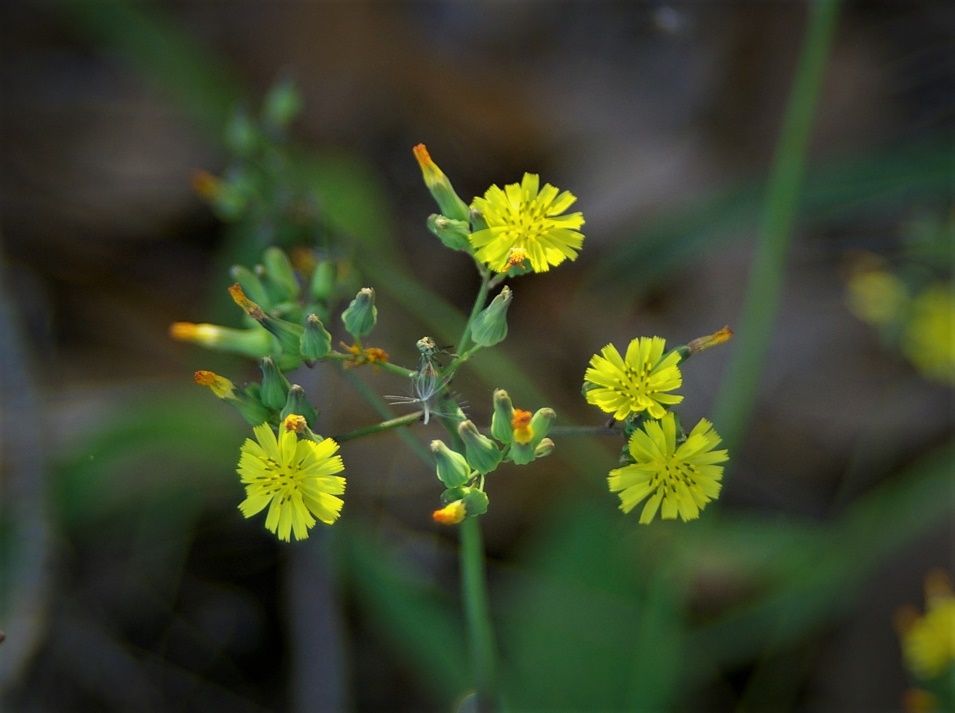Introduction
Asiatic false hawksbeard is a common, annual broadleaf weed found across Florida landscapes, agricultural production systems, home gardens, and natural areas. This article is written for home gardeners, commercial growers, and other green industry professionals to aid in the proper identification and management of Asiatic false hawksbeard in the landscape and in nursery production.
Species Description
Class: Dicotyledonous plant.
Family: Asteraceae, Sunflower family.
Other common names: Oriental false hawksbeard.
Status: Non-native.
Life span: Annual but often persisting year-round in Florida.
Habitat: Asiatic false hawksbeard is commonly found growing around newly planted flower beds, greenhouses, and potting soils and in disturbed sites—such as roadsides or ditches—agricultural production areas, and residential lawns. Studies show that the weed disrupts native plant communities throughout the southeast and mid-Atlantic United States (Flora of North America Editorial Committee, 2018). While it is primarily found in non-wetlands, this false hawksbeard will occasionally grow in wet soils, suited to various pH levels.
Distribution: Native to tropical and subtropical Asia, Youngia japonica has rapidly spread nearly worldwide. In the United States, it can be found in Hawaii and from Pennsylvania to Texas, including all the southeastern states (USDA Plant Hardiness zones 5a–10b) (Rojas-Sandoval, 2018). In Florida, it has been documented nearly throughout the entire state.
Growth habit: Hawksbeard is an herbaceous forb with a solitary, erect growth habit, and usually grows up to 6 to 15 inches in height (occasionally up to 59 inches, dependent upon growing conditions) (Figure 1).

Credit: Annette Chandler, UF/IFAS
Shoot: The lower leaves are simple, spatulate, and hairy, with a lobed margin (Figure 2). Leaves found on the upper portion of the stem are the same as those along the flower stalk: hairless and linear in shape. The leaves and stem will expel a milky sap if damaged. Seedlings of hawksbeard grow in a rosette (circular arrangement), emerging from a central point at the soil line (Figure 3).

Credit: Annette Chandler, UF/IFAS

Credit: Annette Chandler, UF/IFAS
Roots: A thickened, vertical tap root is produced.
Inflorescence: In the United States, Y. japonica primarily flowers from spring to summer; in the Southeast, it can bloom year-round. Flowers, about 0.5 inches in diameter each, are produced on a cyme; each flower can have up to 20 circularly arranged, golden-yellow ray petals (Figure 4).

Credit: Annette Chandler, UF/IFAS
Fruit and seeds: This plant produces abundant seeds that are easily dispersed as a contaminant transported in soil or in crop and grass seed; wind and water can also carry Y. japonica’s seeds. They produce light brown to dark reddish-purple achenes that are about 1.5 mm–2.5 mm in length and fusiform with white, pappus bristles.
Similar species: Forming a rosette, the seedlings can sometimes closely resemble sow thistle (Sonchus spp.) or dandelion (Taraxacum officinale), but the Y. japonica seedlings can be distinguished from the other species by their hairy, linear-shaped upper leaves at maturity. Unlike sow thistle and dandelions, Asiatic false hawksbeard emits a milky sap when damaged or crushed.
Plant biology: Asiatic false hawksbeard is an annual, herbaceous plant that can rapidly spread due to its abundantly produced and easily dispersed seeds. The seeds are self-fertilizing (do not require an external pollinator) with both male and female reproductive structures maturing concurrently (Flora of the North American Editorial Committee, 2018). In the southeastern United States, flowering and seed disbursal occurs year-round, followed by germination and establishment in surrounding areas.
Management
Physical and Cultural Control
Asiatic false hawksbeard thrives in disturbed urban, agronomic, and roadside areas. Residential lawns, walkways, and smaller planting beds can be hand-weeded with ease; when doing so, one must remove both above-soil and underground plant parts. Mowing at the soil line will prove ineffective, as this herbaceous plant will readily regrow if root structures remain. It is thus important to remove the plant before it matures and becomes vigorously rooted in the ground (USDA, NRCS, 2018). Removal of plants prior to seed-set is critical, and one must take care to not distribute any seeds to adjacent areas.
Mulching can help prevent any seed in the soil from germinating or any additional seeds from dropping into the soil. For best results, natural mulches should be applied to non-turf areas, such as planting beds and foot paths, at depths of at least 2 inches (Unruh et al., 2020).
Following recommended guidelines for proper irrigation, fertilizer, and mowing management will promote healthy turf and cultivated areas that will offer plants a greater chance of outcompeting Asiatic false hawksbeard and other weedy species.
Chemical control
Though limited, data on the efficacy of preemergence herbicides indicate that herbicides such as flumioxazin (Broadstar) and OH2 (oxyfluorfen + pendimethalin) may help control Asiatic false hawksbeard (Neal and Derr, 2005). To be effective, preemergence herbicides must be applied prior to weed emergence and should be watered down following application. Treating aggressive weed species after they have established proves itself difficult; the use of preemergence herbicides is thus a favored approach to weed management in many cultivated systems such as container plant production. Generally, many preemergence herbicides are efficacious for a period of 6 to 12 weeks and should be re-applied 6 to 9 weeks later for optimum control (Unruh et al., 2020). For postemergence treatment, pelargonic acid and broad-spectrum or non-selective herbicides—such as glyphosate (Roundup), glufosinate (Finale), and diquat (Reward)—can also be used as spot treatments. Still, these chemicals should be used with care as they can injure non-target ornamentals and turf.
References
Flora of China Editorial Committee. “Youngia japonica (Linnaeus) Cadolle.” In Flora of China, V20–21. Harvard University Herbaria, 2018. http://www.efloras.org/florataxon.aspx?flora_id=2&taxon_id=200024672.
Flora of North America Editorial Committee. “Youngia japonica (Linneaus) de Candolle and A. L. P. P. de Candolle.” In Flora of North America, V19–21. Harvard University Herbaria, 2018. http://www.efloras.org/florataxon.aspx?flora_id=1&taxon_id=200024672.
Hauber, D. P., R. J. Kuhnell, and M. K. Miller. 1989. “Evidence for Predominant Autogamy in Youngia japonica (Asteraceae).” The Southwestern Naturalist 34 (4): 557–9. https://doi.org/10.2307/3671520.
Neal, J. C., and J. F. Derr. 2005. Weeds of Container Nurseries in the United States. Raleigh: North Carolia Association of Nurserymen. http://content.ces.ncsu.edu/static/publication/js/pdf_js/web/viewer.html?slug=weeds-of-container-nurseries-in-the-us.
Rojas-Sandoval, J. 2018. “Youngia japonica (Oriental False Hawksbeard).” CABI Compendium. https://doi.org/10.1079/cabicompendium.117921.
Unruh, J. B., L. E. Trenholm, E. E. Harlow, and R. G. Leon. 2020. “Weed Management Guide for Florida Lawns: ENH884/EP141, Rev. 9/2020.” EDIS 2020 (5). https://doi.org/10.32473/edis-ep141-2019.
USDA-NRCS. 2018. “PLANTS Database.” USDA-NRCS. https://plants.sc.egov.usda.gov.